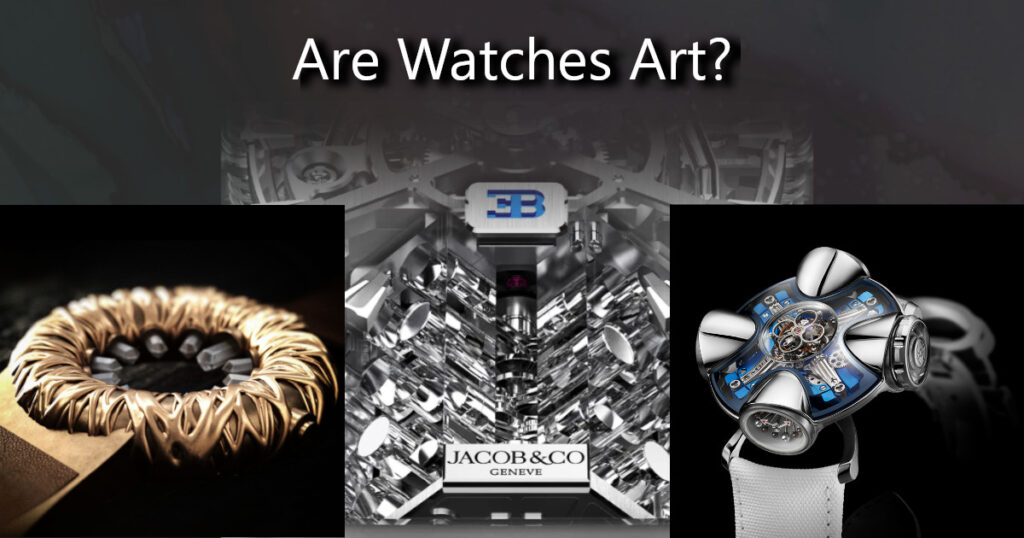
Sections Of This Article:
- Art is enjoyed for its own sake, not for it’s practical usefulness.
- Art is focused more on aesthetics than on functionality.
- Decorative arts.
- Art has special focus
- Art is unique
- Art is creativity relating to conceptual ideas used as a means to communicate, evoke emotions and present challenge perspectives and concepts.
- Art is personal
- So . . . Are watches art?
Introduction
When considering the question: are watches art, there are various factors which, when applying together, define something as art.
Art needs to fulfill all of these factors to be art. So to understand how to judge whether a specific watch is art or not, make sure you understand each of these factors which I’ll explain below.
Watches no longer have an important value in terms of their timekeeping function (with everyone having the precise time on their smartphone), so people, for various reasons, seek to define them as something else of value, especially when they are obviously beautiful and come with hefty price tags, often defining them as “art” without having much understanding of what art really means. This also relates, to some degree, to the aftershocks of the quartz crisis, which polarized watches into either cheap functional items, or expensive, beautiful ones.
The definition of art has broadened through its recent evolution, and been challenged by many, including the Arts And Crafts movement and Art Nouveau which both tried to say that art and craft are equal (by ignoring their different definitions).
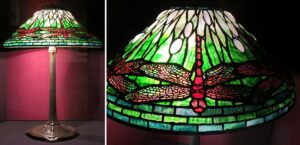
We’ll look at how each of these factors involved in how art is defined, relates to watches . . .
Art Is Enjoyed For Its Own Sake, Not For It’s Practical Usefulness.
Design is primarily enjoyed for its functionality. By contrast. a lot of art has no practical usefulness at all, and is enjoyed for its own sake.
Some art is in between, having some degree of functionality, but is more about how it looks or the concepts it conveys. Examples of this include Art Nouveau objects such as lamps, which have a function, but are seen as much more about how they look than what they do, which makes them accepted as art, and which also relates to the next part of the definition of art, which I detail below.
Art Nouveau (around 1900, see the example above) and the Arts and Crafts movement (mid-19th century Britain) both tried to say that there is no difference between art and craft, by ignoring the real definitions. When you’re read this article, you’ll understand the differences between the two.
An interesting study at the University of London showed that looking at art can create in an instant dopamine release, resulting in feelings and emotions similar to looking at someone you love.
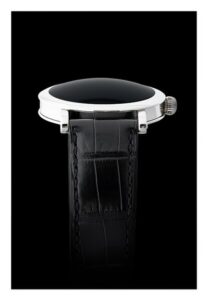
The Haldimann H9 (above), a watch which doesn’t have any form of time-display is an interesting example of moving beyond the functionality inherent in the conventional definition of what a watch is. While it certainly fulfills this criteria of being art, it doesn’t necessarily fulfill all of the necessary parts of the definition of what is art (which I’ll detail below).
This relates to some art jewelry which cannot be worn, and to some examples of the conceptual art movement in the 1960’s to ’70’s which valued concepts over the aesthetic and commercial properties of artworks, sometimes going as far as creating a poster for an art exhibition which would never exist . . . the abstract concept of the possibility of an exhibition itself being the work of art.
Collaborations between artists and watchmakers typically result in a part of the watch, often the dial, having some obviously artistic properties while still having a function.
A few watches have parts which have no functional purpose, such as the “khumeia” by Simon Pierre Delord, which has Art Nouveau influenced metalwork around a small conventional watch face.
Our Fractal Emergence watch has a strong focus on the 3D fractal, which has no practical function at all, and is there to be enjoyed for its own sake.
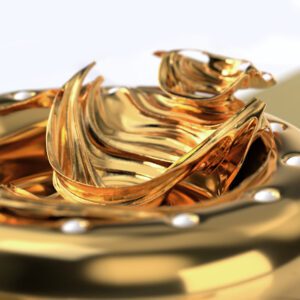
Art Is Focused More On Aesthetics Than On Functionality.
Another difference between art and design is whether the main focus is on aesthetics (with art) or functionality (with design). This is related to the previous part of the definition of art, but is somewhat different (since aesthetics is not necessarily the same as enjoyment, and can even be the opposite). For more on the meaning of aesthetics and how it relates to watches, see my blog post on aesthetic watches.
While this focus on aesthetics often means beauty, this is not always the case, with artistic movements like Dadaism and Punk Rock deliberately choosing aesthetics which are not beautiful. Dadaism’s most famous artwork is “Fountain” by Marcel Duchamp, which is a standard urinal exhibited in an art gallery. Punk Rock also deliberately chooses not to be beautiful.
Art, like beauty is, to some degree at least, in the eye of the beholder. Or to put it another way, while there are some generally agreed differences between beauty and ugliness, aesthetics also includes a significant degree of personal taste.
Watches have mostly been based on functionality until recently, with the evolution of society focusing more on uniqueness, emotional expression, personal exploration and other qualities of art, along with everyone now having the exact time on their smartphone. Less than a century ago, the question about watches being art would not occur, because watches were, although decorated (see below), very much based on their timekeeping functionality. But a lot has changed since then.
Watchmakers have, for most of their history, seen themselves as mechanical engineers, rooted in functionality, unlike the artisans who made fine jewelry.
In horology, there are watches considered by some writers to be “anti-aesthetic”, like the Ochs Und Junior watches with surfaces that celebrate the marks made by the machining process. Holthinrichs watches have a similar choice, proudly showing their 3D printed textures on some parts of their watches:
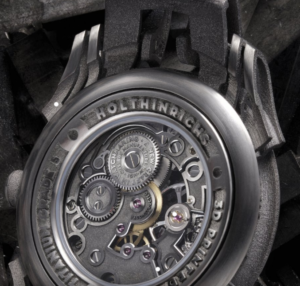
To me, these are examples of watches with an art jewelry influence, because, unlike the fine jewelry focus on smooth polished surfaces, these timepieces align with art jewelry which often uses rough, complex, organic, fractal, or broken surfaces (as well as similarly complex forms).
A watch can be art even if it has a function, if most of the focus is on the aesthetic. The converse is also relevant . . . some watches now have no timekeeping function, like the Haldimann H9 (below), but that doesn’t automatically make them art.

There are a lot of watches these days, especially those which might be seen as unusual or creative, which use engineering with varying degrees of aesthetic focus. Some are designed primarily for function but are also undeniably beautiful. Others involve designing functional components in ways which are not based on what is most practical, but instead focus, to a significant degree, on what looks interesting, while still maintaining functionality.
Other watches go further in terms of adding decorative elements which have no functionality at all.
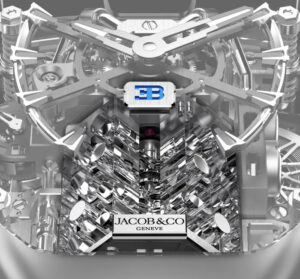
One exceptional example of this is the Jacob and Co. Bugatti Chiron Tourbillon (above), which includes a moving model engine inside the watch . . . “push the right-hand crown of the timepiece and the engine comes to life – the crankshaft turns and the 16 pistons pump up and down, just like a true internal combustion engine. Two “turbochargers” (down from four in the actual Chiron engine) on the side of the engine block spin while the engine runs, adding to the visual impact.”
Our own watches are also examples of timepieces very much more focused on aesthetics than functionality (although they do tell the time) . . .
There are many watches with time-displays which are unusual, or minimal in size. UnconstrainedTime watches are very unusual in that they use the fact that their time-display is very minimal, to allow the main focus of the whole watch to be about the exploration of freely chosen aesthetics, which are unrelated to the engineering or fine jewelry influences of conventional watchmaking.
Examples include the techno circle graphic aesthetics of our Techno Circle #1 watch:
. . . and the fascinating forms of a poppy seed pod which that our Poppy Seed Pod watch are based on:
Decorative Arts.
The commonly accepted meaning of decorative arts is where an object is both functional and beautiful, and are usually seen as design rather than art (yes, this does mean that “decorative art” is not art, however much of a contradiction that may seem in terms of the words used), although this has changed to some degree, for example, while most fine jewelry can be correctly seen as design, and jewelry is traditionally seen as a decorative art, and thus design not art, some art jewelry*** is rightly accepted as art rather than design.
Definitions of fine art, design, etc. have evolved over the years, and I recommend each of us to think for ourselves rather than following the conventions. Gaining the understandings to form one’s own opinions, seems, to me, to be a necessary part of being a unique individual, as most people like to see themselves these days.
Looking at the fundamentals . . . the term “decoration” itself usually refers to an addition intended to make something more attractive. Mr Chris Hall, Watches Editor for MrPorter.com says “When a watch is sensationally decorated, artistic skill can be deployed, but this is purely decoration. It is embellishment of an object that has a role to play beyond the art itself.“
Whether an element of a watch is decorative depends on if it’s fundamental to what the watch is, or if it is an additional element, with there being degrees of how decorative an element of a watch is. Of course, a judgment on what a watch really “is”, is, to some extent at least, a matter of personal opinion.
Early clocks, right from their beginning in the 12th Century, had significant amounts of decoration. Watches being decorated continued until the industrial revolution, when purely functional pocket watches could, for the first time, start being made cheaply enough for ordinary people, and became an important part of the operation of things like railroads.
Wristwatches were originally highly decorated (and highly inaccurate) items for women, and only became significant items in terms of functionality during the first world war, for officers to precisely time military maneuvers without needing to reach into their pockets each time. They became popular in general society after the war ended (although pocket watches continued to be used on the railroads).
The quartz crisis further changed watches from being relatively expensive and beautifully decorated pieces, to being cheap functional objects with no interest in beauty, yet also had polarizing results, leading the Swiss watchmaking industry to become even more focused on higher priced, beautiful timepieces to distinguish themselves from the field of mass-production.
Collaborations between an artist and a watchmaker don’t really result in something which is, as a whole, a unique new piece of art. Most of them are more accurately seen as a watch with some art in it or on it, i.e. an act of addition, i.e. decoration, such as with the fascinating Swatch artist collaborations:
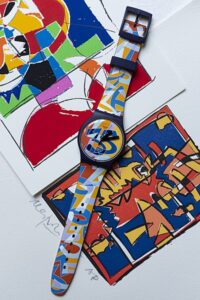
Art Has Special Focus
. . . it presents something as being worthy of unusual attention, unlike most of the experience of everyday life.
Until recently, a big difference between art and watches is how they are usually seen, with watches being meant to be worn in public, although few of the more pricey ones spend most of their time securely locked in vaults. Most types of art tended to stay in one’s home, but now we have wearable art. So art is not always defined by where it is displayed, such as being in a gallery, although a special focus can sometimes be conferred by the way something is presented, as with 4’33” by John Cage, where the normal sounds of the environment are given special focus by a person walking onto a stage in a concert hall, opening the lid of a piano, then (without having touched any of the notes) closing it again 4’33” later.
Another example of the setting determining perceived value is when world famous violinist Joshua Bell went busking in the subway, playing a hugely expensive Stradivarius from 1713, and made only a small sum of money ($52.17 or £42.18), and almost half of that was from someone who recognized him. Which brings up interesting concepts about art, special focus, context, society, etc.
Some art and some watches are obviously valuable to anyone seeing them, others are more discrete, with some paintings by old masters having hung on walls for generations with no-one knowing they were important.
The Dadaists said that something is defined as art by the act of the artist defining it so.
I recommend distinguishing special focus from unusualness, which have some components in common but some which distinguish the two. The way you can stare I wonder at great art for hours is significantly different from the notice something gets from just being different.
Like many aspects of art, what gets special focus is, inevitably, in part, personal. One of my favorite examples of a watch which, for me personally, gets special attention for its artistic merit, is the Mr. Jones Watches Sun and Moon:
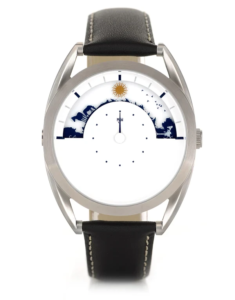
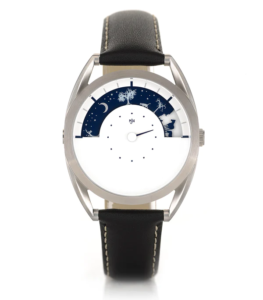
. . . which I find both beautiful and evocative of simpler times, as well as interesting in terms of using a historical method of displaying the time, from before watches with hands were the norm.
My Fractal Emergence watch, for me personally, attract my own special interest in the same my favorite works of art do:
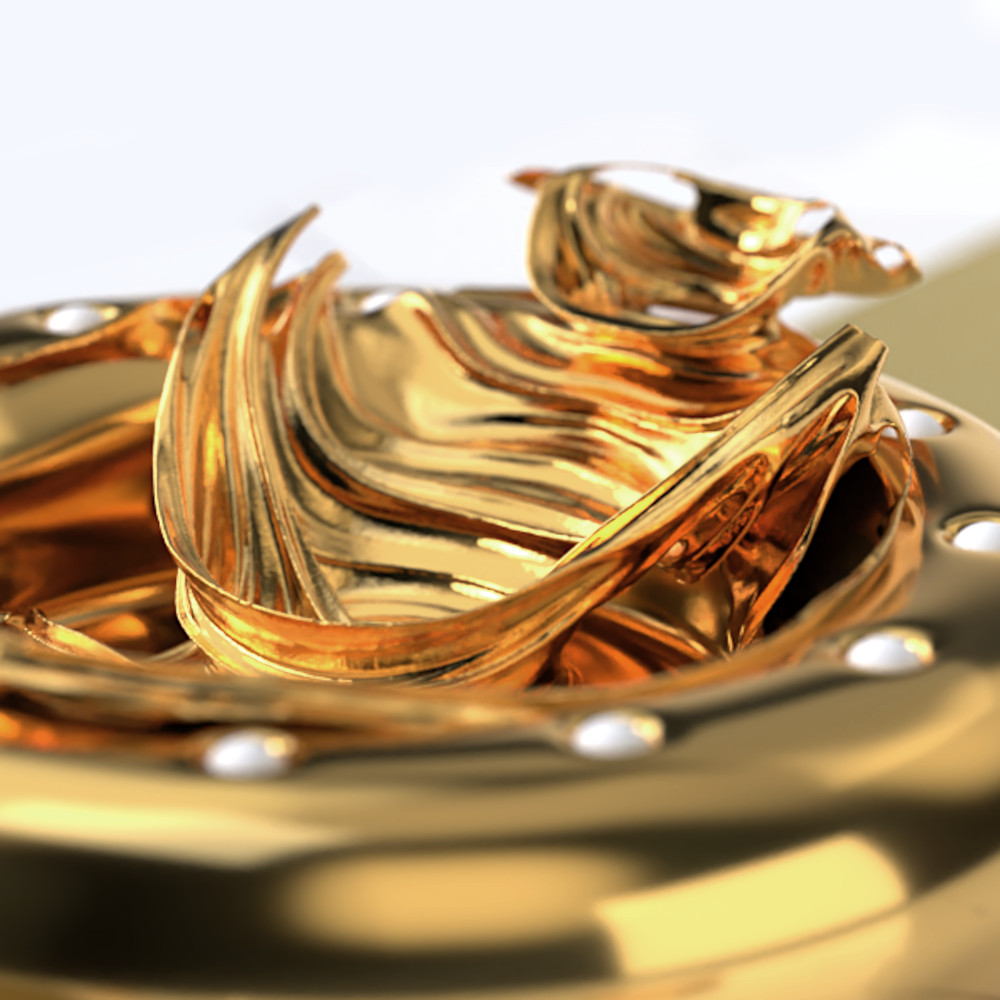
Art Is Unique
A copy of art is not art, although a limited edition of art prints can be.
While fine art is usually a one-off, limited edition fine art prints are a fully accepted part of the art world, although they are limited for the practical reason that the printing surface decays as it is used, which doesn’t apply to watches which can be made in limited editions for good reason, or for less good reasons (I have a look at the reasons behind the love/hate relationship with limited edition watches, here).
A few collaborations between artists and watchmakers produce one-off watches, such as the Bremont Ronnie Wood 1947 Rock On’ Hands Down where each dial is individually hand painted by the artist.
UnconstrainedTime looks forward to collaborating with established creators, to produce one-off artworks which also tell the time, such as by using art jewelry techniques to create unique individual pieces that work in conjunction with the unique UnconstrainedTime time-display. Our collaborations will involve the artist working, by hand, on most of the watch (rather than just one component of it), and even our very minimal time-display can be used in significantly different ways as can be seen from my Tropical Crystal watch where the time is displayed via 12 crystals:
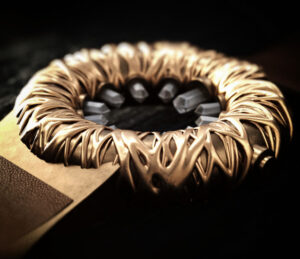
There is a big danger from success as an artist. I had a friend in university who created a very original piece of music which was much admired. He then spent a lot of time trying to create something similar to that, and didn’t again achieve the valuable fresh creativity he originally had.
While art is almost always part of a series of works, each one must always be approached as something new, with, as it’s called “beginner’s mind”. The unique creativity inherent in how each individual artwork is approached and made is an essential part of what makes it successful as art. Each piece of art needs to be created as a new, unique action. The idea from Eastern spiritual perspectives, that action comes “from the void” is part of this concept, and relates specifically to the experience of the fine art process.
If it’s made to try to be like another piece of art, even one of one’s own earlier pieces, it is less likely to be effective. If it’s made to try to be “art”, or to try to be successful, it is less likely to be so . . . “Don’t think about making art, just get it done,” said Mr Andy Warhol. “Let everyone else decide if it’s good or bad, whether they love it or hate it. While they are deciding, make even more art.” Being honest and authentic to the process itself gets better results . . . for example . . .
While I was beginning my education as an artist, I was taking a life-drawing class. The teacher watched me create results that other students crowded around and admired, for a few weeks, then told me that if I continued trying to make what other people admired I wouldn’t progress much. He explained that the best way to improve my work was to be completely honest and authentic about what I was doing . . . if a line was not perfect, even slightly, I should erase it and improve it, while really looking at the subject I was drawing. Then I should not even glance at the results, I should put them away and just continue do more in this way, then after a while I might accidentally glance at my work and notice that my art had genuinely improved. This was challenging to do, to really let go of doing what others admired, but very worthwhile.
It is interesting to note that Picasso, who most people would consider very much an artist, said on his deathbed that nothing he had produced in the last 10 years of his life was really art, he was just doing what people admired.
Uniqueness matters.
Art Is Creativity Relating To Conceptual Ideas Used As A Means To Communicate, Evoke Emotions And Present Challenge Perspectives And Concepts.
I know that’s a bit of a mouthful, but that rather long sentence makes some vital points. Basically, art makes you think, and/or evokes some profound emotional response in you . . . story or concept are an important component of art.
“Art is not what you see, but what you make others see.” – Edgar Degas. Art makes you think conceptually or have some sort of profound reaction. Most impressive engineering creations are not likely to do that for most people, but art should.
For example, it is almost impossible not to experience “Fountain” by Duchamp as art . . . if you disagree that it’s art, that is a profound conceptual and/or emotional reaction, which you’d not get from the same object in its natural habitat, thus you are experiencing one of the affects which does in fact define it as art.
Damien Hirst’s “For the Love of God”, created in 2007, which is a platinum cast of a human skull, encrusted with diamonds, is very likely to evoke emotions or to get the observer thinking about things like money, beauty, precious metals, etc. Some people love his work, others hate it, but either way, it’s creating a significant impression, which is one of the things that art does.
Another example of an artwork which caused a huge impression in its time was “Galloping Horse” by Eadweard Muybridge. People nowadays tend to assume that we’ve always known how horses legs move when they are galloping, but if you look at paintings of horses moving, created before this time, you’ll see that the assumption which everyone held before this artwork was hugely incorrect, which seems almost impossible to comprehend from our current perspective:
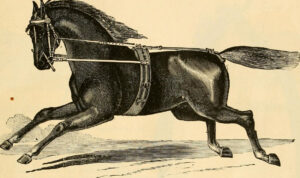
It was only after Eadweard Muybridge took photos of how a horse really moved, that people radically changed their assumptions:
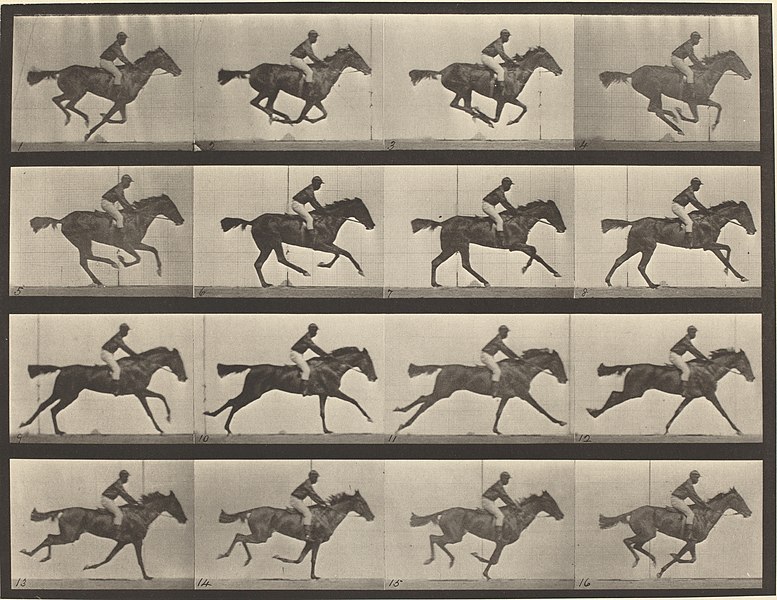
The above example illustrates how people’s ideas of what art is will continue to change and evolve, because the degree to which something will evoke profound emotions or conceptual interest, will change according to the inevitable cultural context which one is looking from.
Expensive watches can be more about factors which increase the monetary value than getting people to think conceptually. And, of course, those who benefit most from calling watches “art,” whether they are or not, are those who are making money from them.
On the other hand, returning once again to the Haldimann H9, that piece is likely to get you thinking about what is, or isn’t, a watch, and maybe about what is, or isn’t, art.
Other examples include complications like those showing the exact positions of each planet, which can hardly be described as having a practical use for most of us, so inevitably place some degree of focus on the concept as well as the engineering accomplishment.
Art Is Personal
. . . it is, to a significant degree, about the person who created it, and an expression of themselves. Art is a personal exploration beyond one’s current reality . . . I detail exactly how this is done, and how it is very different from the design process, in my description of the fine art process***.
Some might say the word which most encapsulates the essence of art, is “expression.”
Art, design, and artisan work or craft, all require skills and experience. But design or artisanal work are not about personal expression . . . if someone else designed or made a very similar object with similar quality and functionality, it would be just as good, but with art, it matters a lot who created it.
Art is personal, as are the very best of creative watches.
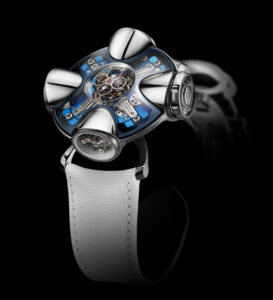
Mr. Büsser of MB&F, said (in this article “where art and timekeeping meet”) about the succession of different watches he has created (one of the latest, the HM11 Architect, is above), that they is that they celebrate the obsessions of his childhood: “I’m writing my autobiography.”
I’ve had a personal fascination with fractals for many years, working with them from a fine art perspective, and also in terms of sound, so it is fitting that our first watch is a fractal:
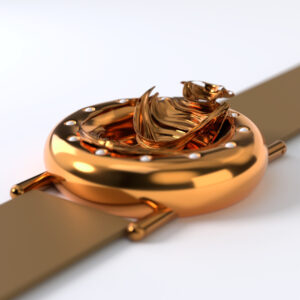
If you like this watch . . . don’t miss our launch . . . subscribe here for notifications.
Art is personal, but self-indulgence ruins artistic potential. While art is very much an exploration of oneself as an artist, it is essential to let the art be what it is itself, rather than trying to gratify the needs of the artist, or indeed, trying to do anything that comes from one’s own conscious intention. I understand this can be challenging to comprehend (I didn’t understand it at all when someone first correctly aimed this criticism at one of my own works, when I was doing Foundation Art), but it is, in my opinion, very well worth understanding.
So . . . Are Watches Art?
Firstly, thanks to other writers from whom I’ve learned fascinating perspectives on this question.
Most writers seem to like to give a definitive “yes” or “no” answer to the question “Are watches art?”, but they also point to the relevant definitions being increasingly blurred and how art, like beauty, is, at least to some degree, in the eye of the beholder.
My answer is that a few watches are art, but where exactly the line is drawn between what is and what is not, art, cannot be defined precisely, and is, at least to some degree, about one’s personal responses to the work in question.
For watches, since many of the best examples are undeniably focused on beauty, are clearly creative, and are worthy of at least some degree of special interest in today’s society, I see the main deciding factors as being:
Is the piece part of a series of personal explorations?
Is the piece producing significant responses in those who see it, such as considering relevant concepts, or experiencing profound emotions?
And is it a watch plus some art, or are the art and the watch inextricably linked?
I invite you to consider those factors in relation to some of the watches you find most interesting. My aim with this article has been to present some of the main points to consider when looking at the question of whether watches are art . . . I’d much rather encourage you to think for yourself than give you an attempt at a definitive answer.
As far as our own watches go, they are some of the first watches where the whole of the watch is created by an artist. My background is fine art and cutting-edge contemporary music . . . I have no training as a watchmaker, so I am not pushing the boundaries of watchmaking, I am starting from a different origin entirely. Our radically minimalist time-display allows more focus on chosen aesthetics than I am aware of in any other watch. As to whether they are art or not . . . that’s not for me to say . . . I’d like to hear your reasons why they are, or are not . . . let us know your views in the comments below or on our social media.



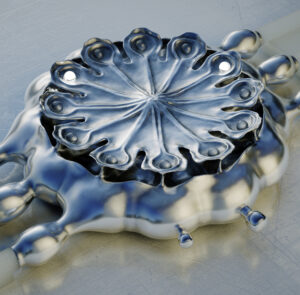

Leave a Reply